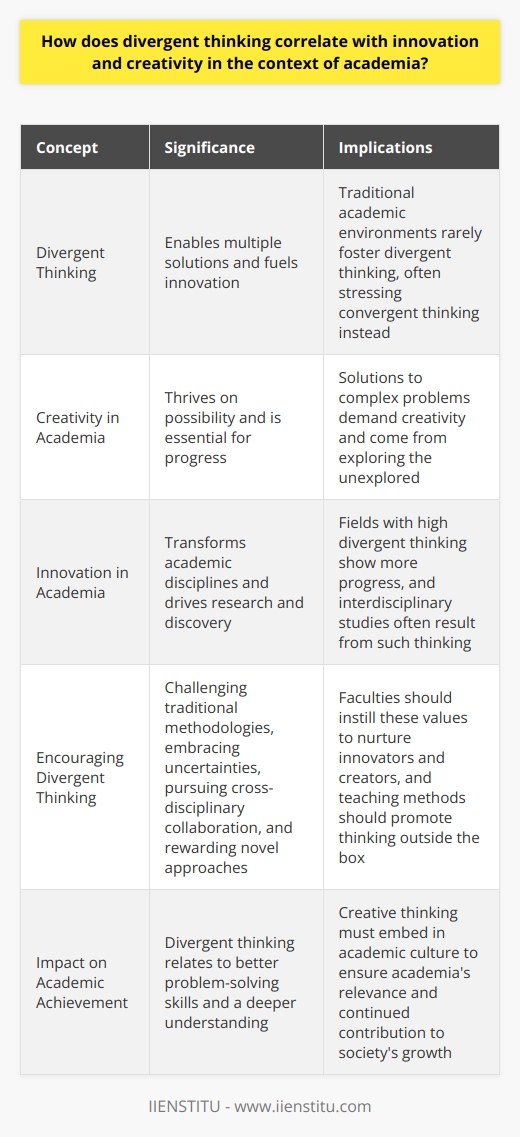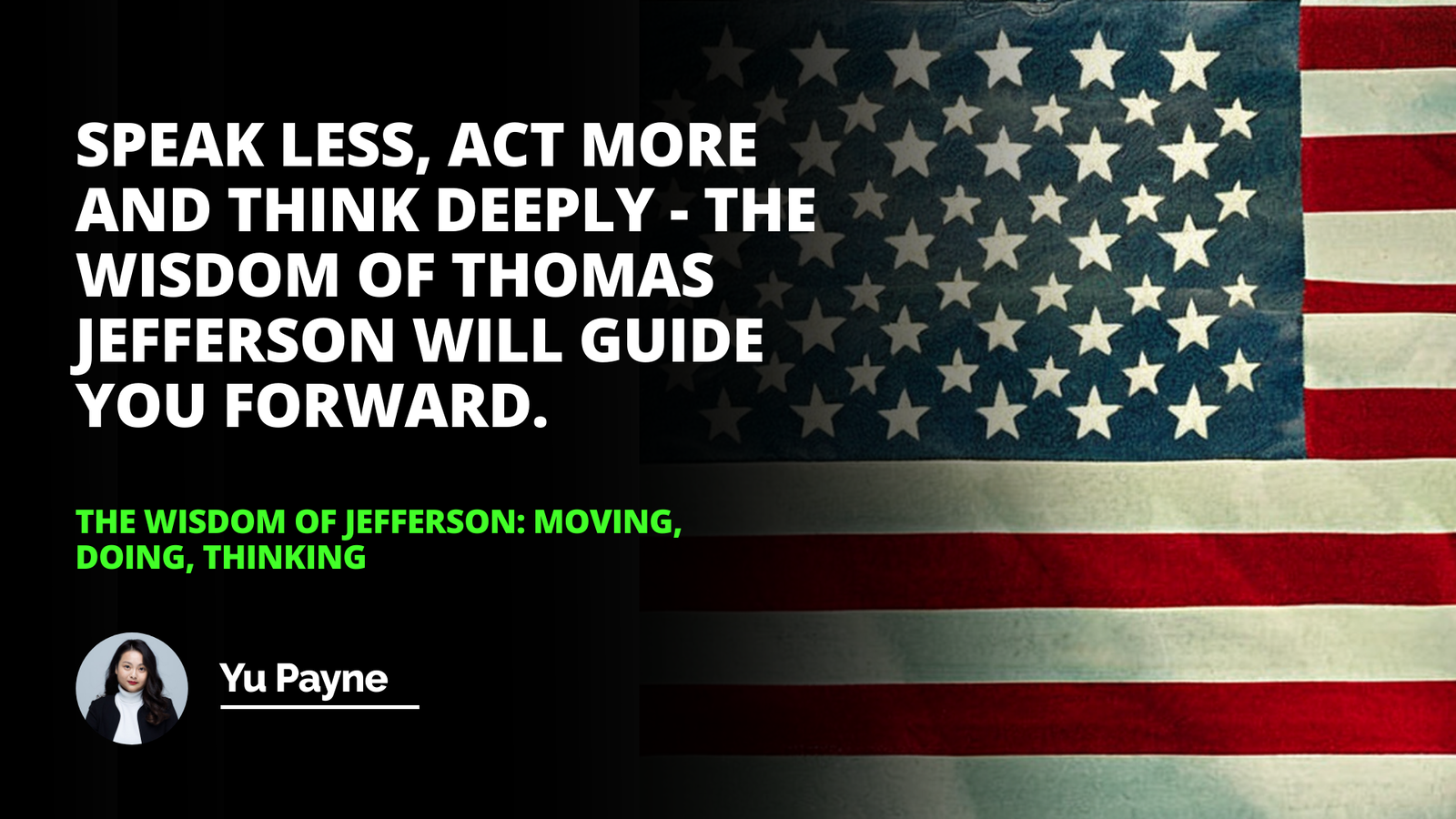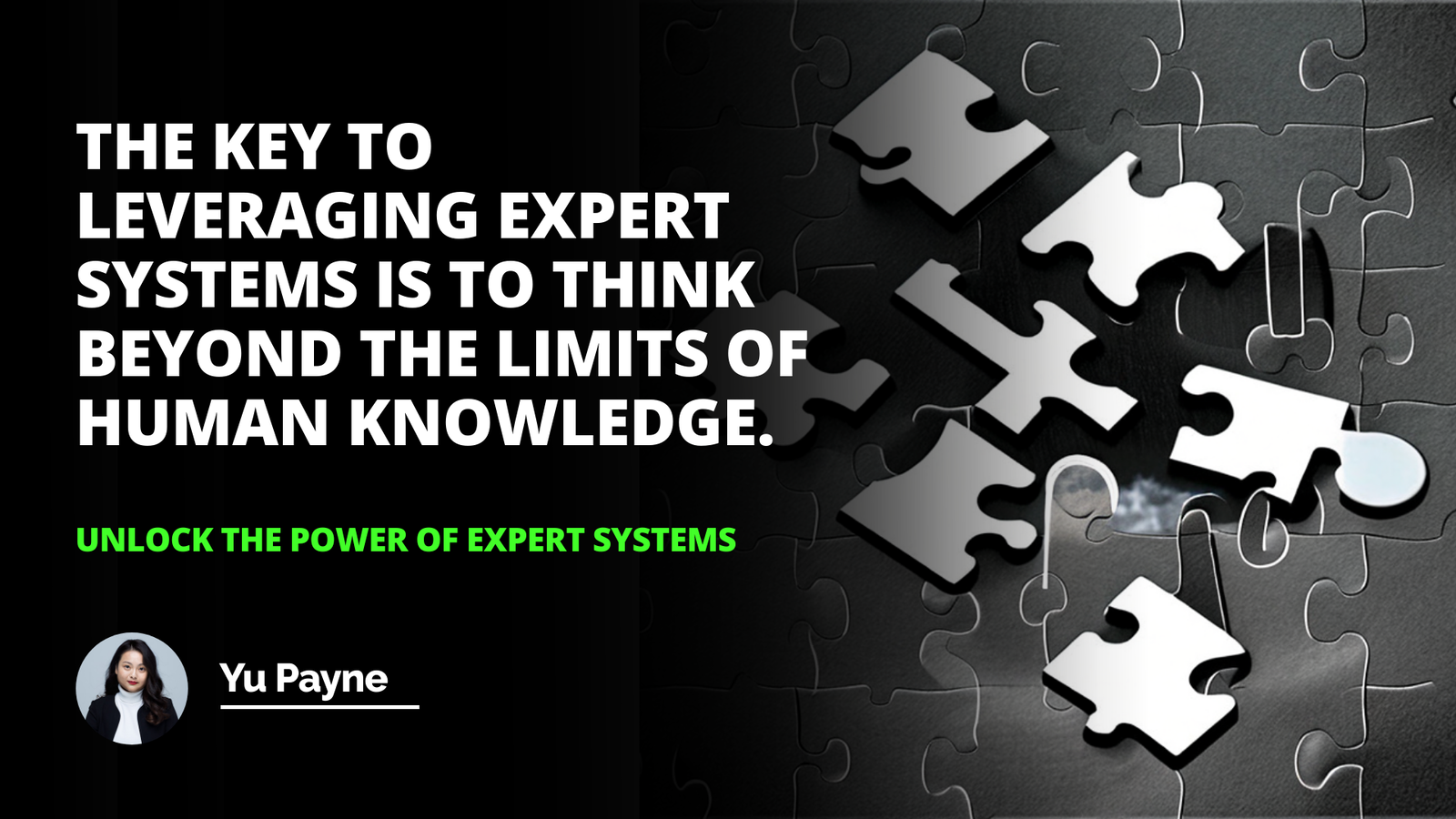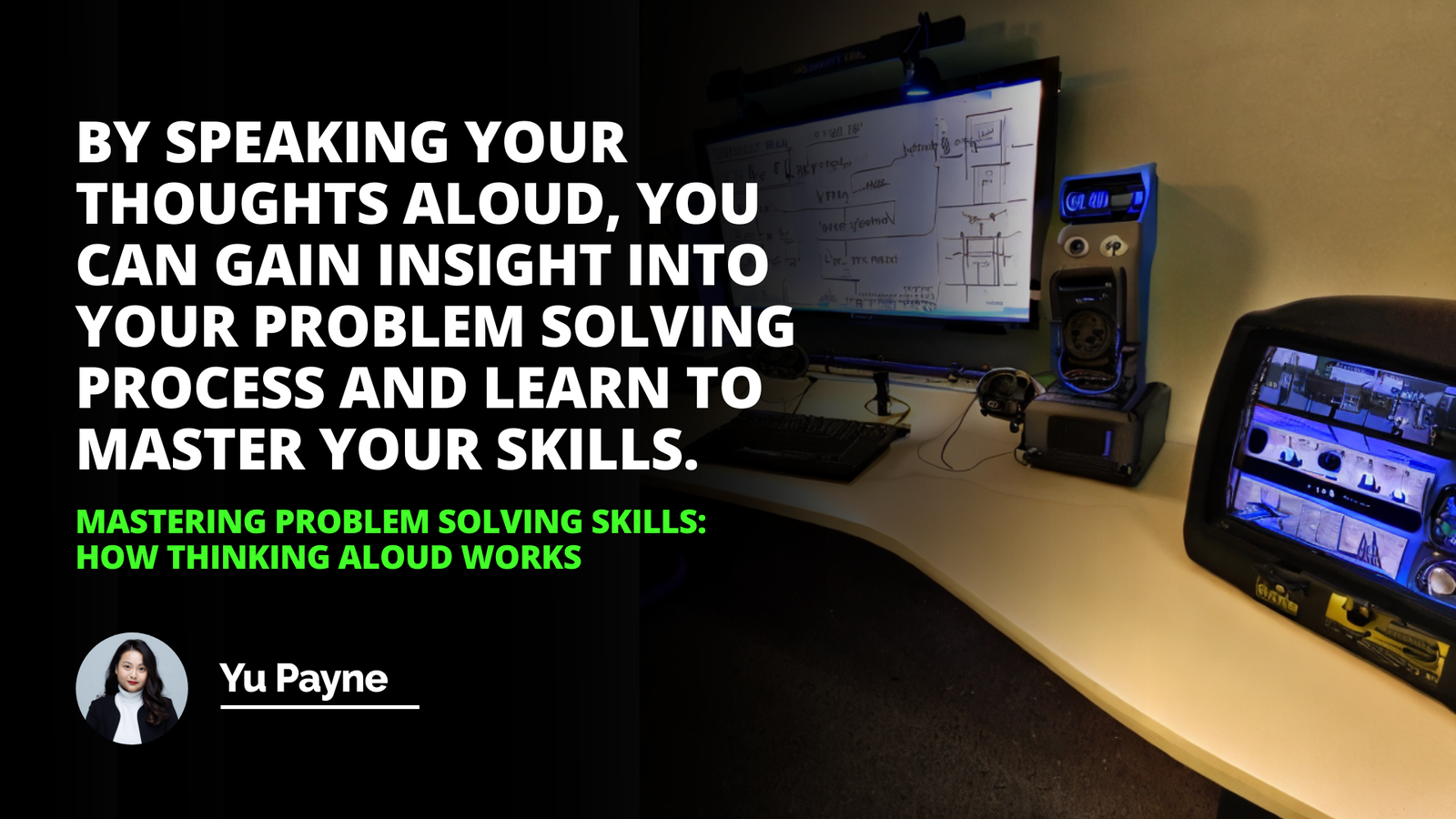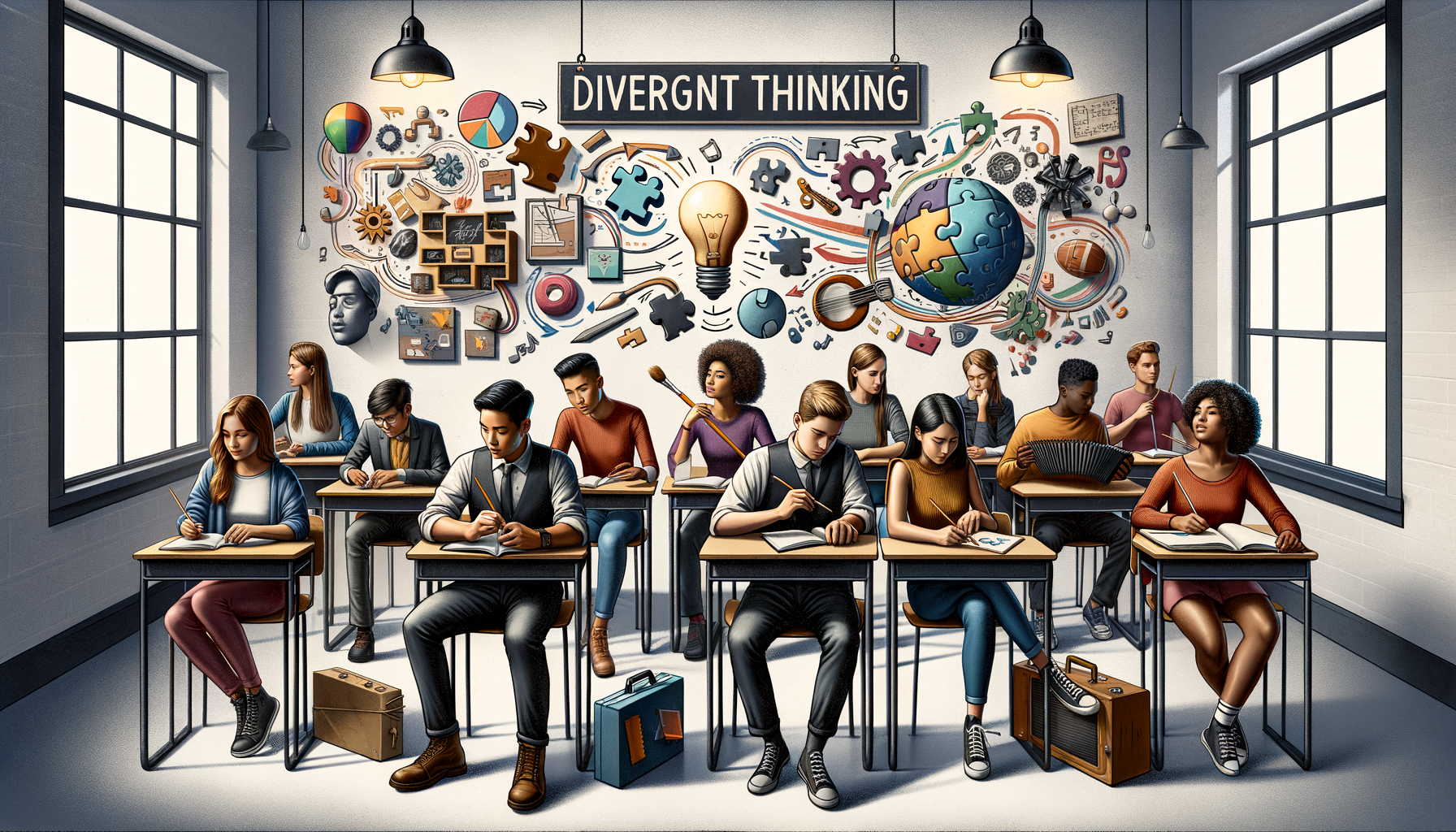
In the contemporary realm of education and professional development, divergent thinking emerges as a pivotal force for driving innovation and problem-solving. This cognitive approach, which allows for the exploration of multiple possible solutions to a given issue, is increasingly recognized as an essential skill in a rapidly changing world. Divergent thinking is more than a mere thought process; it is the bedrock of creativity, underpinning the ability to learn problem solving and adapt to new challenges. It sets the foundation for individuals to not only participate in, but also to shape the future of their respective fields through originality and vision.
Understanding Divergent Thinking
Definition and Explanation of Divergent Thinking: Divergent thinking is often identified as a method of thought that generates creativity through the exploration of numerous potential solutions and ideas. This contrasts sharply with convergent thinking, which is characterized by the pursuit of a single, correct answer to a problem. While convergent thinking applies logical steps to arrive at a solution, divergent thinking involves casting a wide intellectual net, considering all possibilities without immediate judgment or dismissal.
The psychology behind divergent thinking: The cognitive mechanisms that underpin divergent thinking are complex and deeply embedded in the way the brain processes information. Neurologically, it is associated with the activation of myriad neural pathways, allowing for the combination of disparate ideas in novel and unexpected ways. The relationship between divergent thinking and critical thinking is synergistic. While the former is the fuel for generating ideas, the latter is essential in evaluating and refining those ideas to determine their viability.
The role of divergent thinking in creativity and innovation: Within the realms of creativity and innovation, divergent thinking is invaluable. It is the ferment from which groundbreaking ideas and pioneering solutions are born. Divergent thinking does not restrict itself to the arts; it extends across all domains, including sciences, business, and technology. Businesses, academia, and research institutions alike all recognize the imperative need for this thought process that helps in not just solving problems, but redefining them.
The Characteristics of Divergent Thinkers
How To Think Like Einstein To İmprove Problem Solving Skills
Human-centered Design And Design Thinking For User-friendly Products
Identification and discussion of the traits of divergent thinkers: Traits common among divergent thinkers include a remarkable flexibility in thought and an uncontested open-mindedness—they are individuals who consider all angles of a problem and who are not limited by established norms or traditional solutions. Moreover, they can envisage multiple solutions to problems and are characterized by their inquisitiveness and willingness to take risks.
Case studies and examples of successful divergent thinkers: History is replete with examples of successful divergent thinkers. Consider Steve Jobs, whose ability to blend aesthetics with technology redefined consumer electronics. Or Marie Curie, whose relentless inquiry into radioactivity pushed the boundaries of science. Divergent thinking is not exclusive to solitary geniuses; it is a harmonious trait among all innovators who have made strides in their respective fields.
How these characteristics can be nurtured and developed: Divergent thinking is a skill that can be cultivated and refined. Educational systems and workplaces can foster environments that encourage questioning, experimentation, and the challenging of the status quo. By adopting practices that support creative thinking, institutions can nurture the potential divergent thinkers within their ranks, equipping them to make valuable contributions to their fields.
Tools and Techniques to Foster Divergent Thinking
Discussion and explanation of different techniques to enhance divergent thinking: A range of tools and techniques can be employed to cultivate divergent thinking. Brainstorming sessions are foundational exercises that help teams consider a variety of ideas without judgment. Mind mapping is another popular strategy, allowing individuals to visually organize thoughts and identify unexpected connections. The SCAMPER method—Substitute, Combine, Adapt, Modify, Put to another use, Eliminate, Reverse—provides a structured approach to tweaking existing ideas and products. Role-playing can also be a powerful tool, providing insights from different perspectives.
Practical ways to incorporate these techniques into daily routines: For individuals seeking to integrate techniques of divergent thinking into their routines, it is important to create habitual space for ideation. This could manifest as dedicated brainstorming time, routine creative exercises, or even reflective journaling. Additionally, engaging in online certificate courses focused on creative thinking and problem-solving can provide structured learning and practice in these skills.
Nominal case studies or hypothetical examples demonstrating the application of these techniques: Consider an academic setting where students are tasked with tackling a complex social issue. Through brainstorming and mind mapping, they could generate a host of interventions, then apply the SCAMPER method to refine their plans. Alternatively, a business team might role-play as competitors to gain new insights into their own strategies and practices, illustrating the tangible applications of these divergent thinking techniques.
The Benefits of Divergent Thinking
Role of divergent thinking in problem-solving: The essence of divergent thinking in problem-solving lies in its capacity to reveal a wide spectrum of potential solutions, some of which may be profoundly unconventional. This approach excels at navigating complex and ambiguous problems, those without a clear or singular resolution, encouraging thinkers to explore the problem space creatively.
The impact of divergent thinking on personal growth and learning: Divergent thinking stretches beyond problem-solving; it is also instrumental in personal development. It inspires continuous learning and adaptability, traits essential for thriving in the modern world. Through its emphasis on exploration and innovation, it contributes to the development of emotional intelligence and empathy, as individuals are encouraged to view situations from multiple vantage points.
The significance of divergent thinking in organizational success: In an organizational context, divergent thinking is a key factor in fostering collaborative innovation and driving growth. Companies that embrace this mindset, like Google with its renowned '20% time,' where employees can explore independent projects, illustrate how such an approach can yield remarkable dividends.
Throughout this exploration of divergent thinking, the discourse has underscored its indispensable role in catalyzing innovation, shaping learning experiences, and transforming everyday problem-solving. As we navigate a future replete with uncertainty and endless possibility, the value of divergent thinking cannot be overstated. In encouraging the questioning of boundaries and the disruption of conventions, it not only enriches individual minds but advances the collective intellect of society. The potential of divergent thinking is boundless, and its future implications are ripe for discovery, promising a landscape where creativity and adaptability reign supreme.
Frequently Asked Questions
What are the fundamental methods to promote divergent thinking in academic environments?
Encourage Questioning
One fundamental method is to promote questioning. Academics often focus on answers. The true journey begins with a question. Teach students to ask "Why?" and "What if?" Teach them to challenge the status quo. Every subject can benefit from a fresh perspective.
Foster a Creative Environment
Create a space where ideas flourish. A room's layout can spark creativity. Use bright colors and flexible seating. Walls should become idea canvases. Supply resources that invite experimentation. Encourage risk-taking without fear of failure. Failure becomes a stepping stone to innovation in such spaces.
Implement Collaborative Learning
Teamwork nurtures diverse thinking. Different backgrounds bring rich discussions. Group projects allow students to brainstorm together. These collaborations reveal multiple solutions to a problem. They learn negotiation and adaptability. Skills crucial for diverse thinking.
Use Multidisciplinary Approaches
Link subjects together. Show how math relates to art. Explain science through literature. This integration demonstrates the interconnectedness of knowledge. It shows that boundaries in learning are porous. It allows students to transfer skills across disciplines.
Introduce Brainstorming Sessions
Brainstorming is a staple for divergent thinking. Regular sessions harness collective thought power. Set clear rules to make it productive. All ideas deserve attention. Judgment has no place here. Quantity trumps quality in these sessions. Later, analysis will hone the best ideas.
Incorporate Reflection Time
Reflection is vital. It allows students to process their ideas. They can evaluate their own thought patterns. Teachers should allocate time for reflection in their schedules. Self-assessment guides students to understand their creative process.
Provide Exposure to New Experiences
Learning is not confined to the classroom. Field trips, guest speakers, and cultural events expand horizons. Encourage students to travel, even if virtually. Exposure to different cultures and environments broadens their thinking. New stimuli provoke new questions and ideas.
Utilize Technology and Multimedia
Tech tools enable creativity. Apps for mind mapping help organize chaotic thoughts. Online forums provide platforms for sharing and feedback. Videos and podcasts introduce subjects at unique angles. Digital literacy is crucial for contemporary learning landscapes.
Teach Thinking Techniques
Specific strategies develop divergent thinking. Edward de Bono's Six Thinking Hats is one. Another is the SCAMPER method. Teach students these techniques. Provide them with tools to deliberately practice divergent thinking.
Embrace Unstructured Play
Play is powerful. It's often sidelined for structured learning. Yet, play sparks imagination. It relieves the fear of making mistakes. Through play, students explore freely. They experiment with ideas without constraints. It's a natural avenue for innovation.
Challenge Through Problem-Based Learning
Real-world problems engage students. Such challenges have no single answer. They compel students to think broadly. Students become investigators of knowledge. They learn to apply their learning to complex scenarios.
Promote Autonomy in Learning
Self-directed projects empower students. Here, passion drives learning. They follow their curiosity. They learn persistence. Autonomy in learning makes students responsible for their education. It's a breeding ground for divergent thought.
Offer Diverse Literature
Reading broadens minds. Offer books from across genres and cultures. Diverse perspectives within literature stir new ideas. They foster empathy. Empathy allows students to see problems through multiple lenses.
Adapt Assessment Methods
Traditional exams often discourage divergent thinking. Opt for project-based assessments. Focus on creativity, critical thinking, and problem-solving. Allow students to demonstrate their understanding in multiple ways. Divergent thinking thrives when assessment approaches vary.
In summary, academic environments can become incubators for divergent thinking. By infusing these methods, educators can cultivate minds equipped for the complexity of the future. It starts with a shift in mindset—from providing all the right answers to asking all the right questions.

In what ways can academic institutions benefit from fostering environments that encourage divergent thinking?
Fostering Divergent Thinking
Nurturing Innovation
Academic institutions thrive on new ideas. Encouraging divergence stimulates creativity. Students develop unique solutions. Educators research novel concepts. Innovation is the fruit. The result? A robust intellectual community.
Broadening Perspectives
Divergent thinking broadens worldviews. It challenges assumptions. Students learn to question. Educators learn to facilitate. Both parties grow continuously. The institution gains richness. Diversity in thought emerges.
Enhancing Problem-Solving Skills
Real-world problems are complex. They demand creative problem-solving. Divergent thinking equips students. They approach issues holistically. Solutions become multi-dimensional. This adaptability is invaluable.
Increasing Engagement
Engagement means active participation. Divergent thinking demands engagement. Students become more involved. Educators become more inspiring. Classroom dynamics improve. Learning becomes dynamic. Retention rates may rise.
Preparing for the Future
The future is uncertain. Divergent thinking prepares students. They become resilient. They adapt quickly. Employers seek these qualities. Students become top candidates. The institution gains repute.
Encouraging Collaboration
Collaboration drives progress. Divergent thinking encourages cooperation. Each person contributes ideas. Group work flourishes. Social learning occurs. Academic environments become harmonious.
Enhancing Student Satisfaction
Satisfaction leads to success. Divergent thinking can increase satisfaction. Students feel valued. Their ideas matter. This boosts confidence. Success often follows.
Promoting Lifelong Learning
Education doesn't stop. Lifelong learning is key. Divergent thinking encourages curiosity. Students remain lifelong learners. Their passion for knowledge persists. The institution benefits long-term.
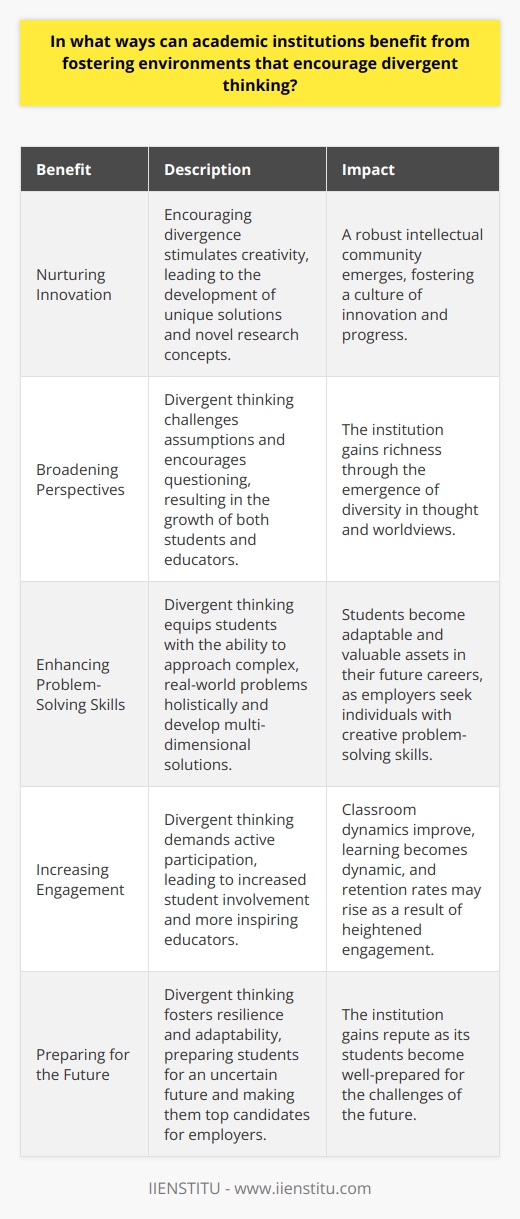
How does divergent thinking correlate with innovation and creativity in the context of academia?
Divergent Thinking in Academia
Understanding Divergent Thinking
Divergent thinking fuels innovation. It enables multiple solutions. Traditional academic environments rarely foster it. They often stress convergent thinking. That's looking for one correct answer. Divergent thinking encourages creativity. It's not just about knowledge. It's about how we use that knowledge.
Divergent Thinking and Creativity
Creativity thrives on possibility. Divergent thinking opens up possibilities. Academia requires creativity for progress. Solutions to complex problems demand it. They aren't found in standard texts. They come from exploring the unexplored. The unknown inspires academic innovative endeavors.
Innovation in Academia
Innovation transforms academic disciplines. It drives research and discovery. Comparative studies show the link is strong. Fields with high divergent thinking show more progress. Interdisciplinary studies often result from such thinking. They blur conventional academic boundaries. New ideas emerge from this blend.
Encouraging Divergent Thinking
- Challenge traditional methodologies
- Embrace uncertainties as opportunity
- Pursue cross-disciplinary collaboration
- Reward novel approaches to problems
Faculties should instill these values. Students become not just thinkers. They become innovators and creators. Teaching methods must reflect this. They should promote thinking outside the box.
The Role of Academia
Academia has a unique role. It doesn't just impart knowledge. It shapes thought leaders. Influences future innovators. It must balance teaching facts. With nurturing creative thought. Shortchanging either compromises academic integrity.
Measuring Divergent Thinking
How does one measure it? Assessments exist but they're imperfect. Creativity tests gauge divergent thinking. Yet they can't fully capture its essence. Numbers seldom do justice to creativity. Yet we know divergent thinking is vital.
The Impact on Academic Achievement
What about academic achievement? Research suggests a positive correlation. Divergent thinking relates to better problem-solving skills. It doesn't reduce to better test scores. It's about a deeper understanding. And the ability to innovate upon it.
Conclusion
Divergent thinking is pivotal in academia. It correlates with innovation and creativity. It cannot be an afterthought. Creative thinking must embed in academic culture. It will ensure academia's relevance. And its continued contribution to society's growth.
